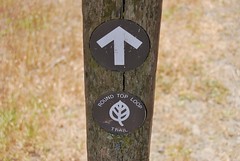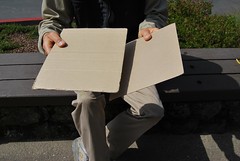Special thanks to Steve Edwards, Isa Polt-Jones and Rosemary Cameron of the East Bay Regional Parks District for their participation.
Robin Marks contributed to this Exploration.
Sibley's Round Top: A Sideways Volcano
Volcanoes in the East Bay? Really?
 As sure as the earth moves in Berkeley, there's a volcano just off Skyline Boulevard. Not just any volcano, mind you. This one's laying on its side with its guts exposed. You might not recognize it right away, owing to its reclining position and the grassy coat it's adopted. But among the shrubs and grasses at Sibley Regional Volcanic Preserve, you'll find the rocky body and layered underpinnings of one of the largest of a handful of volcanoes that once dotted our geologic neighborhood.
As sure as the earth moves in Berkeley, there's a volcano just off Skyline Boulevard. Not just any volcano, mind you. This one's laying on its side with its guts exposed. You might not recognize it right away, owing to its reclining position and the grassy coat it's adopted. But among the shrubs and grasses at Sibley Regional Volcanic Preserve, you'll find the rocky body and layered underpinnings of one of the largest of a handful of volcanoes that once dotted our geologic neighborhood.
Ten million years ago, a vent now called Round Top sprouted in the Earth's crust and regularly spewed thick, gooey lava into its environs. At that time, Round Top stood upright, like a proper volcano, south of present-day San Jose. Over the millennia, the volcano's been ferried northward by the motion of nearby faults, a rugged journey that's changed the appearance of the mountain and the land around it.
A few volcanic basics
 Volcanoes are formed by a host of geological processes-- in particular, one called subduction. During subduction, one of the earth's plates moves over another, pushing the underlying plate down toward the hotter parts of the earth. These giant slabs of earth are made of a variety of rocks and minerals, some of which melt before others as they sink toward the hot mantle. The melted rock, called magma, is lighter and more buoyant than the rocks around and above it. The magma makes its way upward through the earth's crust, often explosively, creating a volcano.
Volcanoes are formed by a host of geological processes-- in particular, one called subduction. During subduction, one of the earth's plates moves over another, pushing the underlying plate down toward the hotter parts of the earth. These giant slabs of earth are made of a variety of rocks and minerals, some of which melt before others as they sink toward the hot mantle. The melted rock, called magma, is lighter and more buoyant than the rocks around and above it. The magma makes its way upward through the earth's crust, often explosively, creating a volcano.
When subduction stops, the fuel that fires a volcano slowly wanes. Here in Northern California, subduction has been slowing in a northward pattern. In other words, volcanic activity stopped first in the southern stretches near Hollister, then near Oakland, then in Sonoma. The area's volcanic rocks get younger and younger as you move northward, until you reach Mt. Lassen, a still active vent that last erupted in 1917.
The story behind Sibley's special volcano
In its early days, Round Top was just a burbling crater. As it erupted, it filled itself with its own volcanic debris and, in time, lava piling on lava created a peak. With more eruptions, the volcano buried itself under hundreds of feet of lava and volcanic ash.
Then, nearby faults began to shift. Slices of the earth's crust moved northward, pushing and bumping things up against each other, creating folds and twists in the landscape. Caught in the action, the land under Round Top began to lean eastward, lifting and tilting until the volcano and all its roots were completely pushed over. The softer rocks that were exposed by this process eroded away, leaving behind a volcanic cauldron filled with its own material, its peak pointing to the east, toward the Sierra Nevada.
To help visualize Round Top's story, imagine the East Bay a bit differently than you usually do: it's no longer a series of neighborhoods comprising Berkeley and Oakland and nearby cities. It's one sprawling, continuous geological story.
The tale is centered at Round Top, which is situated near the juncture of Skyline and Grizzly Peak boulevards in the Oakland hills. But the story streams out from there, across parts of the East Bay landscape. Each day, thousands of cars pass by one strand of it, a 150-foot-thick lava flow exposed just east of the Caldecott tunnel. Next time you're on that stretch of Highway 24, look up at the road cut. The dark brown diagonal rocks forming the high part of the cliff are made of a hardened volcanic rock called basalt.You're driving by lava that erupted from nearby Round Top ten million years ago.
 Southeast of the tunnel, the rocks in Sibley park recount a variety of volcanic events. Outcrops of red and brown rocks record the impact of the steaming lava as it first rolled out onto the cooling surface of the earth. Two rows of broken basalts straddle a more fine-grained rock that was once a fluid lava that moved between the two cooling outer layers. And orange-ish blobs hiding in patches of grass are the result of lava fragments that welded together as they were flying from the volcano, a rare formation, and possibly the only example of it that you can see in California.
Southeast of the tunnel, the rocks in Sibley park recount a variety of volcanic events. Outcrops of red and brown rocks record the impact of the steaming lava as it first rolled out onto the cooling surface of the earth. Two rows of broken basalts straddle a more fine-grained rock that was once a fluid lava that moved between the two cooling outer layers. And orange-ish blobs hiding in patches of grass are the result of lava fragments that welded together as they were flying from the volcano, a rare formation, and possibly the only example of it that you can see in California.
While all these structures leave us impressed with Round Top's activity in its heyday, what really sets Sibley's volcano apart is that it reveals its inner workings to the public in a way rarely seen. Park visitors get a real geology lesson along with these interesting rock formations. To make matters even more revealing, Kaiser Sand and Gravel quarried the area comprising the park years ago. In doing so, they exposed the heart of the volcano, giving park visitors even more history to gander at. Hike out to the quarries and you'll find a variety of rock types in the remains of the quarry pits: hard basalt that was injected into the volcano, forming lakes inside it, and lighter materials like volcanic ash and mud that have been pushed up from horizontal to vertical.
Geologists love road cuts and quarries
While digging and blasting the ground might pose some hazards to local biology, such acts can also reveal remarkable aspects of the earth that would otherwise remain hidden. "Geologists love road cuts and quarries," says paleobotanist Steve Edwards, who mapped Round Top's history as part of his doctorate work. "It's like an outdoor classroom, an incomparable display." And Sibley, in particular, presents visitors with rare opportunities. "There is no other volcano in California whose deep interior is similarly exposed. It's a totally unique site," he says. "It's absolutely incredible that we have this."
Get Involved
Without the help of dedicated volunteers and docents, the East Bay Regional Park District could not offer the public the variety of services and programs that it does. There are many year-round volunteer and docent opportunities for you, your family, or your school or civic group in the Regional Parks. For information, email us at Volunteers@EBParks.org or visit the East Bay Regional Park District's website for upcoming volunteer opportunities.
Latest Visitor Photos



